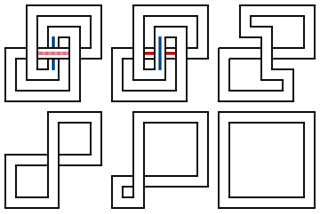
Joel Hass is an American mathematician and a professor of mathematics and at the University of California, Davis. [1] His work focuses on geometric and topological problems in dimension 3.

Joel Hass is an American mathematician and a professor of mathematics and at the University of California, Davis. [1] His work focuses on geometric and topological problems in dimension 3.
Hass received his Ph.D. from the University of California, Berkeley in 1981 under the supervision of Robion Kirby. [2] He joined the Davis faculty in 1988. [1]
In 2012 he became a fellow of the American Mathematical Society. [3] From 2010 to 2014 he served as the chair of the UC Davis mathematics department. [4]
Hass is known for proving the equal-volume special case of the double bubble conjecture, [5] for proving that the unknotting problem is in NP, [6] and for giving an exponential bound on the number of Reidemeister moves needed to reduce the unknot to a circle. [7]
2004: Student Solutions Manual, Maurice D. Weir, Joel Hass, George B. Thomas, Frank R Giordano

In the mathematical field of topology, knot theory is the study of mathematical knots. While inspired by knots which appear in daily life, such as those in shoelaces and rope, a mathematical knot differs in that the ends are joined so it cannot be undone, the simplest knot being a ring. In mathematical language, a knot is an embedding of a circle in 3-dimensional Euclidean space, . Two mathematical knots are equivalent if one can be transformed into the other via a deformation of upon itself ; these transformations correspond to manipulations of a knotted string that do not involve cutting it or passing through itself.
In topological graph theory, a mathematical discipline, a linkless embedding of an undirected graph is an embedding of the graph into three-dimensional Euclidean space in such a way that no two cycles of the graph are linked. A flat embedding is an embedding with the property that every cycle is the boundary of a topological disk whose interior is disjoint from the graph. A linklessly embeddable graph is a graph that has a linkless or flat embedding; these graphs form a three-dimensional analogue of the planar graphs. Complementarily, an intrinsically linked graph is a graph that does not have a linkless embedding.
In general relativity, Regge calculus is a formalism for producing simplicial approximations of spacetimes that are solutions to the Einstein field equation. The calculus was introduced by the Italian theoretician Tullio Regge in 1961.

In the mathematical area of knot theory, a Reidemeister move is any of three local moves on a link diagram. Kurt Reidemeister (1927) and, independently, James Waddell Alexander and Garland Baird Briggs (1926), demonstrated that two knot diagrams belonging to the same knot, up to planar isotopy, can be related by a sequence of the three Reidemeister moves.
Algorithmic topology, or computational topology, is a subfield of topology with an overlap with areas of computer science, in particular, computational geometry and computational complexity theory.
Hilbert's fifteenth problem is one of the 23 Hilbert problems set out in a celebrated list compiled in 1900 by David Hilbert. The problem is to put Schubert's enumerative calculus on a rigorous foundation.

Colin Conrad Adams is a mathematician primarily working in the areas of hyperbolic 3-manifolds and knot theory. His book, The Knot Book, has been praised for its accessible approach to advanced topics in knot theory. He is currently Francis Christopher Oakley Third Century Professor of Mathematics at Williams College, where he has been since 1985. He writes "Mathematically Bent", a column of math humor for the Mathematical Intelligencer.
Jeffrey Clark Lagarias is a mathematician and professor at the University of Michigan.

In mathematics, the unknotting problem is the problem of algorithmically recognizing the unknot, given some representation of a knot, e.g., a knot diagram. There are several types of unknotting algorithms. A major unresolved challenge is to determine if the problem admits a polynomial time algorithm; that is, whether the problem lies in the complexity class P.
In knot theory, a virtual knot is a generalization of knots in 3-dimensional Euclidean space, R3, to knots in thickened surfaces modulo an equivalence relation called stabilization/destabilization. Here is required to be closed and oriented. Virtual knots were first introduced by Kauffman (1999).
Mikhail Khovanov is a Russian-American professor of mathematics at Columbia University who works on representation theory, knot theory, and algebraic topology. He is known for introducing Khovanov homology for links, which was one of the first examples of categorification.
Nonstandard analysis and its offshoot, nonstandard calculus, have been criticized by several authors, notably Errett Bishop, Paul Halmos, and Alain Connes. These criticisms are analyzed below.

In the mathematical area of knot theory, the unknotting number of a knot is the minimum number of times the knot must be passed through itself to untie it. If a knot has unknotting number , then there exists a diagram of the knot which can be changed to unknot by switching crossings. The unknotting number of a knot is always less than half of its crossing number.

In geometry, Keller's conjecture is the conjecture that in any tiling of n-dimensional Euclidean space by identical hypercubes, there are two hypercubes that share an entire (n − 1)-dimensional face with each other. For instance, in any tiling of the plane by identical squares, some two squares must share an entire edge, as they do in the illustration.

In the mathematical theory of minimal surfaces, the double bubble conjecture states that the shape that encloses and separates two given volumes and has the minimum possible surface area is a standard double bubble: three spherical surfaces meeting at angles of 2π/3 on a common circle. It is now a theorem, as a proof of it was published in 2002.

Abigail A. Thompson is an American mathematician. She works as a professor of mathematics at the University of California, Davis, where she specializes in knot theory and low-dimensional topology.

Svetlana Yakovlevna Jitomirskaya is a Soviet-born American mathematician working on dynamical systems and mathematical physics. She is a distinguished professor of mathematics at the University of California, Irvine. She is best known for solving the ten martini problem along with mathematician Artur Avila.